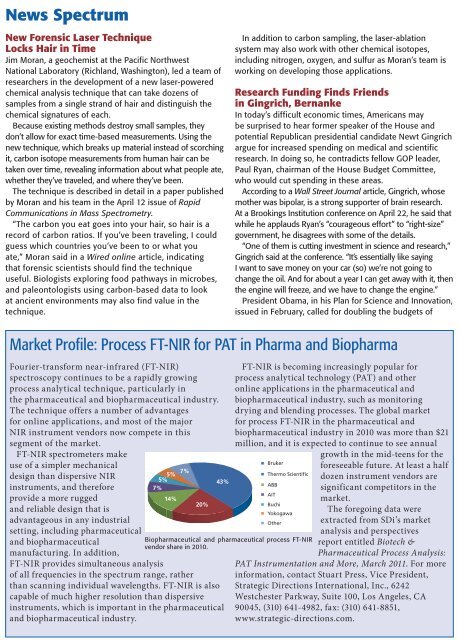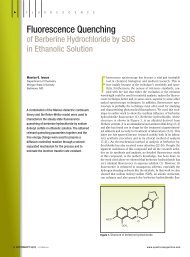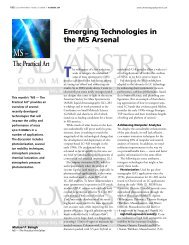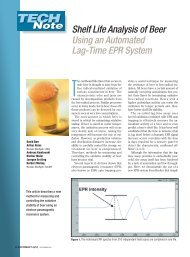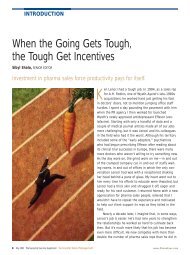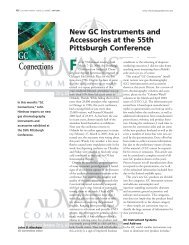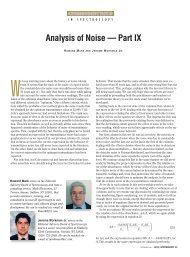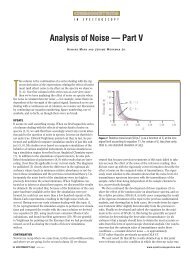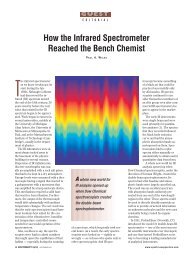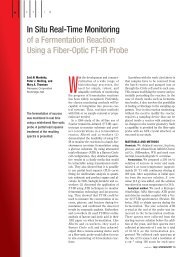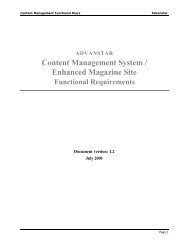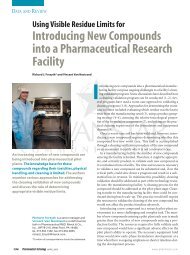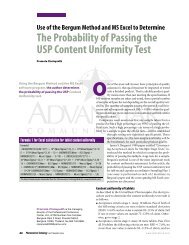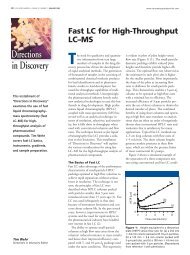Experimental - Spectroscopy
Experimental - Spectroscopy
Experimental - Spectroscopy
Create successful ePaper yourself
Turn your PDF publications into a flip-book with our unique Google optimized e-Paper software.
10 <strong>Spectroscopy</strong> 26(6) June 2011<br />
News Spectrum<br />
New Forensic Laser Technique<br />
Locks Hair in Time<br />
Jim Moran, a geochemist at the Pacific Northwest<br />
National Laboratory (Richland, Washington), led a team of<br />
researchers in the development of a new laser-powered<br />
chemical analysis technique that can take dozens of<br />
samples from a single strand of hair and distinguish the<br />
chemical signatures of each.<br />
Because existing methods destroy small samples, they<br />
don’t allow for exact time-based measurements. Using the<br />
new technique, which breaks up material instead of scorching<br />
it, carbon isotope measurements from human hair can be<br />
taken over time, revealing information about what people ate,<br />
whether they’ve traveled, and where they’ve been.<br />
The technique is described in detail in a paper published<br />
by Moran and his team in the April 12 issue of Rapid<br />
Communications in Mass Spectrometry.<br />
“The carbon you eat goes into your hair, so hair is a<br />
record of carbon ratios. If you’ve been traveling, I could<br />
guess which countries you’ve been to or what you<br />
ate,” Moran said in a Wired online article, indicating<br />
that forensic scientists should find the technique<br />
useful. Biologists exploring food pathways in microbes,<br />
and paleontologists using carbon-based data to look<br />
at ancient environments may also find value in the<br />
technique.<br />
www.spectroscopyonline.com<br />
In addition to carbon sampling, the laser-ablation<br />
system may also work with other chemical isotopes,<br />
including nitrogen, oxygen, and sulfur as Moran’s team is<br />
working on developing those applications.<br />
Research Funding Finds Friends<br />
in Gingrich, Bernanke<br />
In today’s difficult economic times, Americans may<br />
be surprised to hear former speaker of the House and<br />
potential Republican presidential candidate Newt Gingrich<br />
argue for increased spending on medical and scientific<br />
research. In doing so, he contradicts fellow GOP leader,<br />
Paul Ryan, chairman of the House Budget Committee,<br />
who would cut spending in these areas.<br />
According to a Wall Street Journal article, Gingrich, whose<br />
mother was bipolar, is a strong supporter of brain research.<br />
At a Brookings Institution conference on April 22, he said that<br />
while he applauds Ryan’s “courageous effort” to “right-size”<br />
government, he disagrees with some of the details.<br />
“One of them is cutting investment in science and research,”<br />
Gingrich said at the conference. “It’s essentially like saying<br />
I want to save money on your car (so) we’re not going to<br />
change the oil. And for about a year I can get away with it, then<br />
the engine will freeze, and we have to change the engine.”<br />
President Obama, in his Plan for Science and Innovation,<br />
issued in February, called for doubling the budgets of<br />
Market Profile: Process FT-NIR for PAT in Pharma and Biopharma<br />
Fourier-transform near-infrared (FT-NIR)<br />
spectroscopy continues to be a rapidly growing<br />
process analytical technique, particularly in<br />
the pharmaceutical and biopharmaceutical industry.<br />
The technique offers a number of advantages<br />
for online applications, and most of the major<br />
NIR instrument vendors now compete in this<br />
segment of the market.<br />
FT-NIR spectrometers make<br />
use of a simpler mechanical<br />
design than dispersive NIR<br />
instruments, and therefore<br />
provide a more rugged<br />
and reliable design that is<br />
advantageous in any industrial<br />
setting, including pharmaceutical<br />
and biopharmaceutical<br />
manufacturing. In addition,<br />
7%<br />
5% 5%<br />
7%<br />
14%<br />
20%<br />
FT-NIR provides simultaneous analysis<br />
of all frequencies in the spectrum range, rather<br />
than scanning individual wavelengths. FT-NIR is also<br />
capable of much higher resolution than dispersive<br />
instruments, which is important in the pharmaceutical<br />
and biopharmaceutical industry.<br />
43%<br />
FT-NIR is becoming increasingly popular for<br />
process analytical technology (PAT) and other<br />
online applications in the pharmaceutical and<br />
biopharmaceutical industry, such as monitoring<br />
drying and blending processes. The global market<br />
for process FT-NIR in the pharmaceutical and<br />
biopharmaceutical industry in 2010 was more than $21<br />
million, and it is expected to continue to see annual<br />
Bruker<br />
Thermo Scientific<br />
ABB<br />
AIT<br />
Buchi<br />
Yokogawa<br />
Other<br />
Biopharmaceutical and pharmaceutical process FT-NIR<br />
vendor share in 2010.<br />
growth in the mid-teens for the<br />
foreseeable future. At least a half<br />
dozen instrument vendors are<br />
significant competitors in the<br />
market.<br />
The foregoing data were<br />
extracted from SDi’s market<br />
analysis and perspectives<br />
report entitled Biotech &<br />
Pharmaceutical Process Analysis:<br />
PAT Instrumentation and More, March 2011. For more<br />
information, contact Stuart Press, Vice President,<br />
Strategic Directions International, Inc., 6242<br />
Westchester Parkway, Suite 100, Los Angeles, CA<br />
90045, (310) 641-4982, fax: (310) 641-8851,<br />
www.strategic-directions.com.


